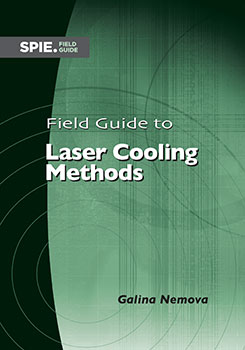|
|
||||||||||||||||||||||||
Introduction to the SeriesWelcome to the SPIE Field Guides—a series of publications written directly for the practicing engineer or scientist. Many textbooks and professional reference books cover optical principles and techniques in depth. The aim of the SPIE Field Guides is to distill this information, providing readers with a handy desk or briefcase reference that provides basic, essential information about optical principles, techniques, or phenomena, including definitions and descriptions, key equations, illustrations, application examples, design considerations, and additional resources. A significant effort will be made to provide a consistent notation and style between volumes in the series. Each SPIE Field Guide addresses a major field of optical science and technology. The concept of these Field Guides is a format-intensive presentation based on figures and equations supplemented by concise explanations. In most cases, this modular approach places a single topic on a page, and provides full coverage of that topic on that page. Highlights, insights, and rules of thumb are displayed in sidebars to the main text. The appendices at the end of each Field Guide provide additional information such as related material outside the main scope of the volume, key mathematical relationships, and alternative methods. While complete in their coverage, the concise presentation may not be appropriate for those new to the field. The SPIE Field Guides are intended to be living documents. The modular page-based presentation format allows them to be updated and expanded. We are interested in your suggestions for new Field Guide topics as well as what material should be added to an individual volume to make these Field Guides more useful to you. Please contact us at fieldguides@SPIE.org. John E. Greivenkamp, Series Editor College of Optical Sciences The University of Arizona Related Field GuidesKeep information at your fingertips with these other SPIE Field Guides:
Other related SPIE Press books:
Table of ContentsPrefaceCooling or refrigeration is based on heat removal and dates back thousands of years to when people tried to preserve their food using ice and snow. The laser—a groundbreaking scientific achievement of the 20th century— has revolutionized the cooling process. The advent of lasers brought laser cooling, also known as optical refrigeration, into existence. Today, laser cooling and its applications represent one of the major subfields of atomic, molecular, and solid state physics. This Field Guide provides an overview of the basic principles of laser cooling of atoms, ions, nanoparticles, and solids, including Doppler cooling, polarization gradient cooling, different sub-recoil schemes of laser cooling, forced evaporation, laser cooling with anti-Stokes fluorescence, hybrid laser cooling, and Raman and Brillouin cooling. It also covers radiation-balanced lasers and Raman lasers with heat mitigation, and considers the basic principles of optical dipole traps, magnetic traps, and magneto-optical traps. This Field Guide will serve both to introduce students, scientists, and engineers to this exciting field, and to provide a quick reference guide for the essential math and science. I would like to thank SPIE Press Manager Timothy Lamkins and Series Editor John Greivenkamp for the opportunity to write a Field Guide for one of the most interesting areas of photonics, as well as SPIE Press Sr. Editor Dara Burrows for her help. This book is dedicated to my mom, Albina. Galina Nemova September 2019 GlossaryFundamental constants
Glossary of Symbols and Acronymsρ density operator σ a absorption cross section σ e emission cross section ψ wave function ω angular frequency B magnetic field E electric field EF Fermi energy gF Landé g-factor gl electron orbital g-factor gs electron spin g-factor k wave vector kr restoring-force constant t time T temperature v velocity vs speed of sound Quantum mechanical symbolsd atomic dipole moment F total angular momentum quantum number (used by spectroscopists for atoms with an odd isotope number) F total angular momentum (for atoms with an odd isotope number)
magnitude of the total angular momentum F I nuclear spin angular momentum j total angular momentum quantum number (for a single particle) J total angular momentum quantum number (used by spectroscopists for atoms with an even isotope number) J total angular momentum (for atoms with an even isotope number)
magnitude of the total angular momentum J l orbital angular momentum quantum number or orbital quantum number (for a single particle) L orbital angular momentum quantum number (for a system of several particles) L orbital angular momentum (for a system of several particles)
magnitude of the orbital angular momentum L ml magnetic quantum number n principal quantum number (for a single particle) s spin quantum number (for a single particle) S spin quantum number (for a system of several particles) S spin angular momentum (for a system of several particles)
magnitude of the spin angular momentum S Acronyms and AbbreviationsAC alternating current ASF anti-Stokes fluorescence BEC Bose–Einstein condensate BYF BaY2F8 CARS coherent anti-Stokes Raman scattering CG Clebsch–Gordan (coefficient) CNBZn CdF2-CdCl2-NaF-BaF2-BaCl2-ZnF2 DC direct current ED electrical dipole EIT electromagnetically induced transparency EM electromagnetic ESA excited-state absorption EQ electric quadrupole f-factor oscillator strength FMHM full width at half maximum GEF geometrical efficiency factor IPTS International Practical Temperature Scale KPC KPb2Cl5 LD Lamb–Dicke (regime) LO longitudinal optical MAT minimum achievable temperature MD magnetic dipole MOT magneto-optical trap ODT optical dipole trap PSD phase-space density QM quantum model RE rare earth RF radiofrequency rms root-mean-square RWA rotating-wave approximation SCM semi-classical model SHG second harmonic generation SLT second law of thermodynamics SNR signal-to-noise ratio SRAP stimulated Raman adiabatic passage SRE selective resonant enhancement SSRS stimulated Stokes Raman scattering STIRAP stimulated Raman adiabatic passage TA transverse acoustic TIR total internal reflection TO transverse optical TOF time-of-flight TOP time-orbiting potential VECSEL vertical-external-cavity surface-emitting laser VSCPT velocity-selective coherent population trapping VUV vacuum ultraviolet YAG Y3Al5O12 (yttrium aluminium garnet) YLF YLiF4 (yttrium lithium fluoride) ZBLAN ZrF4-BaF2-LaF3-AlF3-NaF ZBLANP ZrF4-BaF2-LaF3-AlF3-NaF-PbF3 (heavy-metal fluoride glass) |
CITATIONS
Laser scattering
Laser applications
Solids
Imaging systems
Chemical species
Raman spectroscopy
Ions


